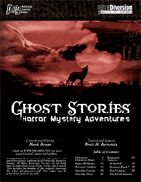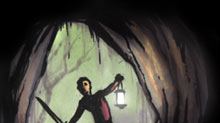by Demian Katz
 Ghost Stories: Horror Mystery Adventures
Ghost Stories: Horror Mystery Adventures
Concept and editing by Mark Bruno
System and layout by Brett M. Bernstein
Published by Politically Incorrect Games
36 page PDF
$4
With Ghost Stories: Horror Mystery Adventures, the second in their line of genreDiversion Quick Fix Games, Politically Incorrect Games has entered the field of fast-playing horror role-playing. This isnít entirely unexplored territory, as Deep7ís somewhat disappointing Shriek pioneered the genre. However, while Shriek was meant to emulate the thrills of cheesy slasher movies, Ghost Stories aspires to be more flexible, supporting all kinds of horror subgenres and time periods. Obviously, thereís only so much you can do in 36 pages, but it seems like a good GM should be able to get considerable mileage out of what is provided here. Regardless of its uses, this product improves upon several of the problems I complained about in my review of Hardnova: Space Opera Adventures while still being of somewhat mixed quality. The previous book was consistently solid but undistinguished, while this one improves the character creation options but loses ground in the usability of its scenarios.
The Full (Ghost) Story
In Hardnova, I was disappointed by the way in which large amounts of space were devoted to Psionic Powers when only characters with the Psion background could use them. This meant that psionics could only be used by dedicated psionicists, limiting the types of characters that could be created. I was also a little confused by the fact that the Willpower trait only had one associated skill when the other traits supported numerous options. In Ghost Stories, these flaws have been nicely fixed. There are three different backgrounds which can give characters Psionic-like powers: Blessed (which allows True Faith skills), Medium (which allows the use of ESP), and Sorcerer (which allows Sorcery spellcasting). Because of this, the rules serve a greater variety of character concepts, and since two of these types of special powers (Sorcery and True Faith) are resolved using Willpower, that particular trait feels more useful. These special skills, particularly Sorcery, also serve to make the game more interesting because they come with consequences. Casting a spell can attract unwanted attention or lead to difficult obligations, and casting a spell incorrectly can be totally catastrophic. A creative GM could get a lot of mileage out of this aspect of the game, though thereís also a risk that it could totally derail an adventure. Either way, the added risks of power help to balance the game and make it stand out a little from the crowd.
When I reviewed Hardnova, I was rather dismissive of its game system. I stand by the comment that itís nothing new, but perhaps my overall appraisal was a little harsh. While reading through the rules for the second time in Ghost Stories, I did gain a certain appreciation for the straightforward nature of the system; I even gained a better understanding of a couple points that confused me the first time around. I also appreciate the way in which the layout uses icons to concisely present certain adjustments to dice rolls. Itís still just the same old ďadd attribute and skill, then roll diceĒ thing weíve all seen a million times before, but itís a very user-friendly variation.
Between the rules and the scenarios, Ghost Stories includes a section entitled ďThe Horrors.Ē These three pages list nineteen creatures the players may eventually encounter along with details of special abilities that these entities may possess. Most of this stuff is pretty standard-issue (poltergeists, werewolves, zombies), though there are a couple original creations and potential sources of adventure seeds. Still, like Hardnova and the rest of this book, the writing is never especially engaging and the overall inventiveness is low, so your imagination would be better fired by a good book of actual ghost stories; this is best used simply to get an idea of how supernatural creatures can be (loosely) represented within the gameís system.
In Hardnova, I complained that while it was admirable that the scenarios were so easy to pick up and play, they lacked twists and creative plots. Here, the problems are worse and the positive features are weaker. Some of the scenario ideas are a little bit more original than those in the previous game, but the originality is often offset by silly or excessively implausible events (one adventure, for example, has the players make investigation rolls to spot things on and about a body that the coroner really shouldnít have missed). More seriously, these scenarios really arenít, for the most part, ready to run. Some of the vague details are a good thing, because they allow the storylines to be set in different time periods, and advice is included on how to do this. Other omissions, however, are unfortunate. The first scenario, for example, encourages the GM to let the players explore a large house but doesnít include a map or suggested layout even though thereís adequate whitespace for such a thing. Another scenario involves a foe with followers, and while stats are included for the main enemy, nothing is given for typical followers, again despite the presence of whitespace where such information could have been put in. Some GMs will probably take a less critical view of these adventures than I did, but the bottom line is that thereís nothing here that makes you think ďI have to run this game with my group!Ē At best, the reaction is more likely to be ďwith a little work, I might be able to use this.Ē
The presentation here is very similar to that of the previous game. As before, I have no complaints about the layout except with regard to the cover and character sheets. The cover here is nearly all black, just like that of Hardnova, making it a real waste of ink or toner to print out. The character sheets donít share this wastefulness as they did in Hardnova (a major improvement), but they have a new problem: much of the text on them is written in the creepy-looking font used elsewhere in the book for headings. While the font is fine to head a section, when itís smaller and used for an extended period, itís not too kind on the eyes. Finally, as before, I found a lot of typos; however, I expect that these will all be corrected by the time this review is posted.
Conclusions
Once again, I canít make strong recommendations for this product, though there are certainly reasons why you might want to add it to your collection. If youíre looking for something original, look elsewhere (try DeProfundis if you want a horror RPG thatís really out there). If youíre looking for something with easy-to-run (though sci-fi) scenarios that you can pick up and play immediately, youíre probably better off with Hardnova. If you want a flexible but fast and simple horror game system and youíre willing to do some work to create good adventures to use with it, though, this just might be for you. As far as Iím concerned, the genreDiversions line still hasnít had a great hit, but perhaps when more unique genres are explored, the perfect balance will be reached. I guess I have a soft spot for RPGs of this length and format, because I know Iíll be watching in anticipation.
| Related reviews on OgreCave: |
|
|




